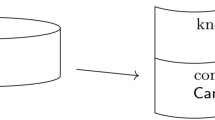Abstract
Given a finite set \(\mathcal{C} := \{ C_1, \ldots, C_n\}\) of description logic concepts, we are interested in computing the subsumption hierarchy of all least common subsumers of subsets of \(\mathcal{C}\). This hierarchy can be used to support the bottom-up construction and the structuring of description logic knowledge bases. The point is to compute this hierarchy without having to compute the least common subsumer for all subsets of \(\mathcal{C}\). We will show that methods from formal concept analysis developed for computing concept lattices can be employed for this purpose.
This work was partially supported by the Deutsche Forschungsgemeinschaft Grant No. GRK 185/3-98.
Preview
Unable to display preview. Download preview PDF.
Similar content being viewed by others
References
Baader, F.: Computing a Minimal Representation of the Subsumption Lattice of all Conjunctions of Concepts Defined in a Terminology. In: Proceedings of KRUSE 1995(1995)
Baader, F., Küsters, R.: Computing the least common subsumer and the most specific concept in the presence of cyclic \(\mathcal{ALN}\)-concept descriptions. In: Herzog, O. (ed.) KI 1998. LNCS, vol. 1504. Springer, Heidelberg (1998)
Baader, F., Küsters, R., Molitor, R.: Computing least common subsumers in description logics with existential restrictions. In: Proceedings of IJCAI 1999. Morgan Kaufmann, San Francisco (1999)
Borgida, A., Patel-Schneider, P.: A semantics and complete algorithm for subsumption in the Classic description logic. J. Artificial Intelligence Research 1 (1994)
Cohen, W.W., Hirsh, H.: Learning the Classic description logic: Theoretical and experimental results. In: Proceedings of KR 1994. Morgan Kaufmann, San Francisco (1994)
Donini, F.M., Lenzerini, M., Nardi, D., Hollunder, B., Nutt, W., Spaccamela, A.M.: The complexity of existential quantification in concept languages. Artificial Intelligence 53 (1992)
Dowling, W.F., Gallier, J.H.: Linear-time algorithms for testing the satisfiability of propositional Horn formulae. J. Logic Programming 3 (1984)
Duquenne, V.: Contextual implications between attributes and some representational properties for finite lattices. In: Beiträge zur Begriffsanalyse. B.I. Wissenschaftsverlag (1987)
Frazier, M., Pitt, L.: Classic learning. Machine Learning 25 (1996)
Ganter, B.: Finding all closed sets: A general approach. Order 8 (1991)
Ganter, B., Wille, R.: Formal Concept Analysis – Mathematical Foundations. Springer, Heidelberg (1999)
Horrocks, I.: The FaCT system. In: de Swart, H. (ed.) TABLEAUX 1998. LNCS (LNAI), vol. 1397, p. 307. Springer, Heidelberg (1998)
Marquardt, W.: Trends in computer-aided process modeling. Computers and Chemical Engineering 20(6/7) (1996)
Nassiri, M.: Berechnung einer erweiterten Subsumtionshierarchie. Diploma thesis, RWTH Aachen, Germany (1997)
Sattler, U.: Terminological Knowledge Representation Systems in a Process Engineering Application. PhD thesis, RWTH Aachen (1998)
Stumme, G.: Exploration Tools in Formal Concept Analysis. In: Proceedings of OSDA 1995. Studies in Classification, Data Analysis, and Knowledge Organization, vol. 8. Springer, Heidelberg (1996)
Stumme, G.: The concept classification of a terminology extended by conjunction and disjunction. In: Foo, N.Y., Göbel, R. (eds.) PRICAI 1996. LNCS, vol. 1114. Springer, Heidelberg (1996)
Stumme, G., Wille, R.: Begriffliche Wissensverarbeitung — Methoden und Anwendungen. Springer, Heidelberg (2000)
Vogt, F., Wille, R.: TOSCANA - A graphical tool for analyzing and exploring data. In: Tamassia, R., Tollis, I.G. (eds.) GD 1994. LNCS, vol. 894. Springer, Heidelberg (1995)
Author information
Authors and Affiliations
Editor information
Editors and Affiliations
Rights and permissions
Copyright information
© 2000 Springer-Verlag Berlin Heidelberg
About this paper
Cite this paper
Baader, F., Molitor, R. (2000). Building and Structuring Description Logic Knowledge Bases Using Least Common Subsumers and Concept Analysis. In: Ganter, B., Mineau, G.W. (eds) Conceptual Structures: Logical, Linguistic, and Computational Issues. ICCS 2000. Lecture Notes in Computer Science(), vol 1867. Springer, Berlin, Heidelberg. https://doi.org/10.1007/10722280_20
Download citation
DOI: https://doi.org/10.1007/10722280_20
Publisher Name: Springer, Berlin, Heidelberg
Print ISBN: 978-3-540-67859-5
Online ISBN: 978-3-540-44663-7
eBook Packages: Springer Book Archive




